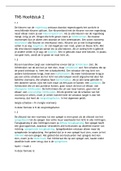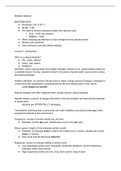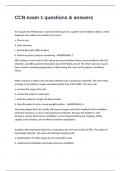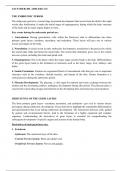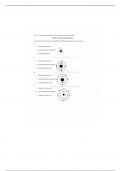Chapter 1
Nature of Business and Accounting
A business provides goods or services to customers, with the aim to
earn a profit. There are 3 types of business:
- Service; provide services rather than products to customers.
(KLM – transportation services)
- Merchandising; sell products they purchase from other
businesses to customers. (Albert Heijn)
- Manufacturing; change basic inputs into products that are sold
to customers. (Mercedes Benz – cars)
Accounting is an information system that provides reports to users
about the economic activities and condition of a business. There
are 2 groups users of accounting information:
- Managerial Accounting is (private) for internal users;
accountants, managers and employees.
- Financial Accounting is for external users; investors, creditors,
customers and government.
Ethics (doing the right or wrong thing) are moral principles that
guide the conduct of individuals. Accountants and managers have
to be fair by the information they have given, otherwise he will be
fired or prosecuted.
Sarbanes-Oxley Act (SOX); A list of laws (PCAOB) to monitor the
behaviour of accounting and business, to avoid frauds.
Accountants have 2 opportunities:
- Private accounting; employed by companies, government or
not-for-profit organisations.
- Public accounting; employed by an accounting firm.
Generally Accepted Accounting Principles (GAAP)
GAAP; a collection of accounting standards, principles and
assumptions that define how financial information will be reported.
, - Accounting standards; the rules that determine the accounting
for individual business transactions.
- Accounting principles and assumptions; provide the
framework upon which accounting standards are constructed.
Financial information has to be; relevant and faithful presentation
(accurate information).
Principles Assumptions
Measurement Monetary unit
Historical cost Time period
Revenue recognition Business entity
Expense recognition Going concern
Arm’s-length transactions; transactions between 2 independent
parties (objective and verifiable).
Revenue; the amount earned for selling goods or services to
customers.
Expenses; amounts used to generate revenue.
IFRS = International Financial Reporting
Statement of Cash Flows
3 main sections:
- Operating activities
- Investing activities
- Financing activities
The above activities result in an overall cash increase or decrease.
Debt to Equity ratio = (Total liabilities/Total stockholders’ equity)
The Accounting Equation
Assets; the economic recourses owned by a business (cash, land,
buildings); left of the balance
Liabilities; the present obligations to pay cash, transfer assets, or
provide services to other entities (bank loan, accounts payable,
unearned revenue); right of the balance
Equity; the claim by the owners of a company to the assets of the
business; right of the balance
, - Stockholders’ equity = equity owned by the owners of a
corporation (retained earnings & common stock).
- Owners’ equity = equity owned by the owners of a
proprietorship, partnership or limited liability company.
ASSETS = LIABILITIES + EQUITY (always equal)
Page 56 Exhibit 2!
Purchase on account; you pay the bill later (account payable).
Earn on account; you get the money later (account receivable).
Stockholders’ equity; the money that left from the fees earned after
paying the expenses
Nature of Business and Accounting
A business provides goods or services to customers, with the aim to
earn a profit. There are 3 types of business:
- Service; provide services rather than products to customers.
(KLM – transportation services)
- Merchandising; sell products they purchase from other
businesses to customers. (Albert Heijn)
- Manufacturing; change basic inputs into products that are sold
to customers. (Mercedes Benz – cars)
Accounting is an information system that provides reports to users
about the economic activities and condition of a business. There
are 2 groups users of accounting information:
- Managerial Accounting is (private) for internal users;
accountants, managers and employees.
- Financial Accounting is for external users; investors, creditors,
customers and government.
Ethics (doing the right or wrong thing) are moral principles that
guide the conduct of individuals. Accountants and managers have
to be fair by the information they have given, otherwise he will be
fired or prosecuted.
Sarbanes-Oxley Act (SOX); A list of laws (PCAOB) to monitor the
behaviour of accounting and business, to avoid frauds.
Accountants have 2 opportunities:
- Private accounting; employed by companies, government or
not-for-profit organisations.
- Public accounting; employed by an accounting firm.
Generally Accepted Accounting Principles (GAAP)
GAAP; a collection of accounting standards, principles and
assumptions that define how financial information will be reported.
, - Accounting standards; the rules that determine the accounting
for individual business transactions.
- Accounting principles and assumptions; provide the
framework upon which accounting standards are constructed.
Financial information has to be; relevant and faithful presentation
(accurate information).
Principles Assumptions
Measurement Monetary unit
Historical cost Time period
Revenue recognition Business entity
Expense recognition Going concern
Arm’s-length transactions; transactions between 2 independent
parties (objective and verifiable).
Revenue; the amount earned for selling goods or services to
customers.
Expenses; amounts used to generate revenue.
IFRS = International Financial Reporting
Statement of Cash Flows
3 main sections:
- Operating activities
- Investing activities
- Financing activities
The above activities result in an overall cash increase or decrease.
Debt to Equity ratio = (Total liabilities/Total stockholders’ equity)
The Accounting Equation
Assets; the economic recourses owned by a business (cash, land,
buildings); left of the balance
Liabilities; the present obligations to pay cash, transfer assets, or
provide services to other entities (bank loan, accounts payable,
unearned revenue); right of the balance
Equity; the claim by the owners of a company to the assets of the
business; right of the balance
, - Stockholders’ equity = equity owned by the owners of a
corporation (retained earnings & common stock).
- Owners’ equity = equity owned by the owners of a
proprietorship, partnership or limited liability company.
ASSETS = LIABILITIES + EQUITY (always equal)
Page 56 Exhibit 2!
Purchase on account; you pay the bill later (account payable).
Earn on account; you get the money later (account receivable).
Stockholders’ equity; the money that left from the fees earned after
paying the expenses



